#Jonathan Scarfe
Text
I watched Judas (2004) and welp
So erm this was supposed to just be a couple sentences but ended up becoming a full-blown rant, please bare with me
WARNING: SPOILERS AHEAD AND BRIEF MENTIONS OF SUICIDE ⚠️

So basically it all started when Judas saw Jesus going bonkers in the temple and got really horny-

Then he decided to invite Him back to his place for some grapes (malewife mode activated)

Afterwards Caiaphas and co. abduct Judas (this happens a total of three times) and attempt to blackmail him
Caiaphas calls Judas ‘son’

Judas ignores Caiaphas and runs away with Jesus. They start play-fighting and end up wrestling on the ground
Jesus says “I want you to spend eternity with me“

Unfortunately the harmony is short-lived. Judas sees Jesus hugging Matthew and gets jealous

Pilate, Herod and Caiaphas regularly get together for tea and crumpets
Here Judas is basically the stand-in for Simon Zealots. We learned that his father died in an attempt to stir up a Jewish insurrection. Flower!child Jesus asks Judas why he’s staying despite their contradicting beliefs and he replies: “I’m drawn to you like a thirsty horse to a riverbed” 😳
Babygirl 🌸

Supportive mama Iscariot tells her son he should invite his new boyfriend over for Passover, then promptly dies

OMG THE KISS
Judas really just smushed their faces together 🥴

The cinematic choices here are really cool, Jesus is almost always surrounded by light Star Wars hologram lookin ass whereas Judas is consumed by shadow the edgelord
After turning Jesus in Judas instantly regrets it, and tries to get the apostles together to rescue Him. It doesn’t work (obviously) so he screams and cries his way through the trial before going to hang himself
His last thought is of Jesus asking him to join the Eternal Kingdom 🥺

JESUS AND JUDAS’ DEATHS PARALLEL EACHOTHER
The disciples take Judas down because they know it’s what Jesus would have wanted, praying for him as the screen fades to black
The end 🥲
Conclusion
Judas has the vibes of an early 2000s made-for-tv movie (which it is) so I got what I came for. Definitely a fun ride if you like JCS and want to see attractive people acting out a biblically-inaccurate rendition of The Passion in the style of Gladiator (2000) or Troy (2004). The language used is modern, everyone speaks in American or English accents. Pilate even uses the term ‘rabble-rousing’ Overall I give Judas 18 silver pieces out of 30, for being corny and anachronistic but homoerotic enough to satiate all the freaks out there like me
To think this all could have been prevented if Judas just took his iron pills
Bonus quotes:
“Don’t leave me, I thought I was special to you!”
-Judas
“I wish you could love yourself the way I love you.”
-Jesus
P.S. I’ve seen Jonathan Scarfe referred to as ‘the whinier Glenndas’ so please proceed with caution if you do plan on giving it a watch! Here’s the link:
#okay I think that’s everything#judas movie#the passion#jesus christ#judas iscariot#jesus chris superstar#bible posting#jonathan scarfe#johnathon schaech#television drama#caiaphas#pontius pilate#king herod
129 notes
·
View notes
Text






#Movie&TV#jesus x judas#Judas 2004#Jonathan Scarfe#Johnathon Schaech#jesus christ#Judas#judas iscariot#jesus of nazareth#jesus
43 notes
·
View notes
Text

Van Helsing (2016) Stay Inside
S1E3
When the hospital's power source is damaged, Vanessa and the survivors only have three hours of reserve power for the UV lights - the only thing keeping the vampires at bay. While Vanessa and Axel head into the ruins of Seattle to scavenge parts, the others are left to fight: against both vampires and among-st themselves.
#van helsing#tv series#2016#action#drama#fantasy#vampires#Kelly Overton#Jonathan Scarfe#Vanessa Helsing#Axel Miller#Stay inside#horror#just watched
5 notes
·
View notes
Photo

Van Helsing - Season 5
Quality : HD Screencaptures
Amount : 12316 files
Resolution : 1280x720px
- Please like/reblog if using!
#van helsing#vanhelsingedit#kelly overton#jonathan scarfe#caroline cave#kim coates#heather doerksen#Tricia Helfer#dan cade#capped by randomkiwibirds
3 notes
·
View notes
Text
#Van Helsing#Netflix#𝗧𝗩#Jesse Stanley#Rukiya Bernard#Vincent Gale#Jonathan Scarfe#Christopher Heyerdahl#Luvia Petersen#Hilary Jardine#Sarah Desjardins#Tricia Helfer
0 notes
Text
EQUALIZER 2:
Rob McCall returns
To avenge an old partner
Job hits close to home
youtube
#the equalizer#equalizer 2#random richards#poem#haiku#poetry#haiku poem#poets on tumblr#haiku poetry#haiku form#poetic#robert mccall#denzel washington#pedro pascal#the Equalizer 2#ashton sanders#orson bean#bill pullman#melissa leo#Jonathan scarfe#antoine fuqua#richard wenk#Michael Sloan#Richard Lindheim#Youtube
1 note
·
View note
Text

Hi guys. MORE Jonathan Sims because he’s probably the best character ever written tbh




#the magnus archives#fanart#the magnus archive fanart#jonathan sims#8th doctor#Jon is such a doctor who fan#I think his 8th Doctor scarf was knitted by his nan#and it was like the only thing he ever wore#but she made a little tiny matching one for his rabbit#gerard kaey
932 notes
·
View notes
Note
I'd love to hear about your coloring/pose choices once you post your turnarounds ~
oh! well, while i'm here, i might as well post what i have so far


(the first 2 turns are their initial look, the third is their final look)
so! with jonathan, i initally went for a homely, warm look - he's fresh and a little nervous, kitted out in travelling gear that i'm sure he (and/or mina) bought especially for the occasion - i feel like he hasn't gone much beyond england before. i admit i was kind of spiteful and stole the red scarf from the league of extraordinary gentlemen's mina - which made this discovery from the milwaukee ballet version all the more serendipitous! by the end, he, like everyone, is in funeral gear, but he retains the scarf - it's matted and covered and grime, but it stays there. it helps break up the black, but also, it could maybe stand for a lot of Thematic Motifs, like love, sex, transgression, and, uh, blood. take your pick. also - not that important and it's hard to see, but i hc him with dark grey eyes, and when his hair changes, i really like the idea of his eyes becoming paler and washed out looking.
for mina, i wanted her to seem to seem unremarkable on first glance, but if you look closer, her outfit is supposed to be slightly masculine, with the waistcoat and collar. that's as much as she allows herself, though. she's a woman in a financially and socially vulnerable situation, and so i feel like she's someone who cares a lot about how she presents herself, and i wanted this to show. for her end-of-book look, i wanted her to match jonathan somewhat with the vampiric vibes. in her case, it's literal, so i took her eyes from a dark brown to deep red, and she's a very uncharacteristic mess. in both cases, i feel i was maybe a LITTLE on the nose with the dracula-eque vibes at the end, but whatever! who cares. she can wear what is essentially a red silk-lined dracula cloak because she should be able to have a bit of vampire swag in this testing time
#also i think it was linguisticparadox on the server who came up with the cosmic brain idea that mina knitted his scarf for him....cry#it makes everything so much more meaningful too#anyway. jonathans final look is very much alexa play wasteland by the mission#i'm about to start on van helsing which should be fun. by the end i want a full lineup that i can bung in my portfolio#WOW this is so much more explanation than what really went into these small drawings afhkafl
1K notes
·
View notes
Text

cold, not lonely
#this isn’t mag 159 it’s just winter no worries#they look like they need scarfs or something though#my art#the magnus archives#jonathan sims#martin blackwood#jmart#jonmartin#magnuspod#painting
2K notes
·
View notes
Text

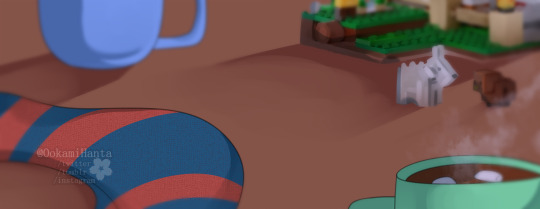
winter
#dc#damian wayne#jonathan kent#damijon#jondami#aj art#jon gave dami a lego farm set and dami made jon a scarf lol#spring is gonna be a fun one hehe#idk if anyone is gonna notice this so ill just say it. summer and autumn take place in kansas. winter and spring are going to be in gotham
341 notes
·
View notes
Text
Eddie: I’m kinda cold
Steve: *wearing nothing but his boxers and a t-shirt*
Steve: ah shit
Steve: *takes off his shirt*
Eddie: *panicking* WHAT THE FUCK
Eddie: ARE YOU DOING
Eddie: WHERE ARE YOUR CLOTHES?
Robin: *wearing Steve’s jacket* you see Eddie
Nancy: *steve’s scarf around her neck* Steve doesn’t like it when his friends are cold
Jonathan: *wearing Steve’s sweater* you can’t fight it
Argyle: *Steve’s sweatpants on, over his jeans* because he will put them on you one way or another
Steve: *throws it at him* just take the damn t-shirt
Eddie:
Eddie: *nosebleeds*
#Robin is so used to take Steves jacket that its their jacket now#nancy coughed once and she immediately felt the scarf on her neck#jonathan shivered because of a gust of wind and sighed because he knew what steve would do#argyle complained about a hole in his jeans and 5 seconds later Steve was forcing him into his sweatpants#eddie has no chance to escape#they all hug steve so he doesn't feel the cold dw#they're in a cuddle pile as we speak#incorrect stranger things#incorrect steddie#incorrect steddie quotes#incorrect stranger things quotes#spicy six as friends#spicy six#fruity four#steddie#steve and eddie#steve harrington#steve and robin
688 notes
·
View notes
Text














2 notes
·
View notes
Text
By: Jonathan Haidt
Published: Dec 22, 2023
[Note: this is post #1 of a pair of posts. The second post gives the text of chapter 3 of The Coddling of the American Mind.]
In the days after the October 7 Hamas attack on Israel, university campuses immediately distinguished themselves as places set apart from the rest of American society—zones where different moral rules applied. Even before Israel began its military response, the loudest voices on campus were not university leaders condemning the attacks and vowing solidarity with their Jewish and Israeli students. Instead, the world saw faculty members and student organizations celebrating the attacks.
Political commentator and Atlantic author David Frum summed up the moral uniqueness of the academy in this tweet, four days after the attack:
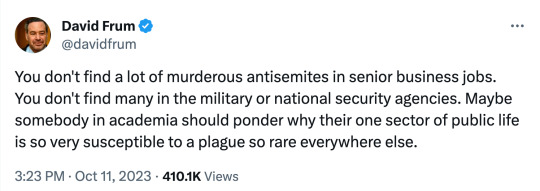
Since then, there have been hundreds of antisemitic incidents on campuses including vandalism of Jewish sites, physical intimidation, physical assault, and death threats against Jewish students, often from other students. The response from university administrators has often been slow, weak, or entirely absent.
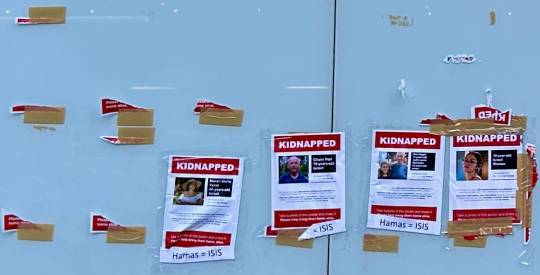
[ Image. The scene on the exterior wall of my office building at NYU on the morning of October 17, 2023. NYU students had posted fliers about Israelis kidnapped by Hamas. Other NYU students tore them down. Other NYU students posted more of them. ]
Why is the culture of elite higher education so fertile for antisemitism, and why are our defenses against it so weak? Don’t we have the world's most advanced academic concepts and bureaucratic innovations for identifying hatred of all kinds, even expressions of hatred so small, veiled, and unconscious that we call them “micro-aggressions” and “implicit biases”?
Yes, we do, but it turns out that they don’t apply when Jews are the targets,1 and this was the shocking hypocrisy on display in that Congressional hearing room on December 5. Congresswoman Elise Stefanik asked the President of the University of Pennsylvania “Does calling for the genocide of Jews violate Penn's rules or code of conduct, yes or no?” President Magill was unable to say yes. When the question was asked in various ways to all three presidents, none could say yes. All said variations of “it depends on the context.”
Now, as a social psychologist who studies moral judgment, I’m all for context. Technically, those presidents were correct that students chanting “from the river to the sea” may or may not be advocating killing all the Jews in Israel. Those chanting “globalize the intifada” may or may not be calling for terrorist attacks on Jewish sites around the world. And even if they were, such political speech is protected by the First Amendment unless the speech is made in a context that is likely to incite actual violence, constitutes a “true threat,” or rises to the level of discriminatory harassment. Those three presidents could have said that their universities are bastions of free speech where everyone lives and dies by the First Amendment.
In fact, they tried to say that, and this is why they were so widely pilloried for hypocrisy. Like most elite schools, Harvard, Penn, and MIT have spent the last ten years punishing professors for their research findings and disinviting speakers who questioned the value of DEI. (See The Canceling of the American Mind for dozens of other examples.) As has been widely reported, Harvard and Penn are the top two schools in America for creating terrible speech climates, according to the Foundation for Individual Rights and Expression.
What on earth happened to the academy? As Fareed Zakaria recently asked: How did America’s elite universities go from being “the kinds of assets the world looks at with admiration and envy” just eight years ago, to becoming objects of ridicule today? How did we bungle things so badly?
Greg Lukianoff and I wrote a book that tried to answer that question in 2018, as it was happening.
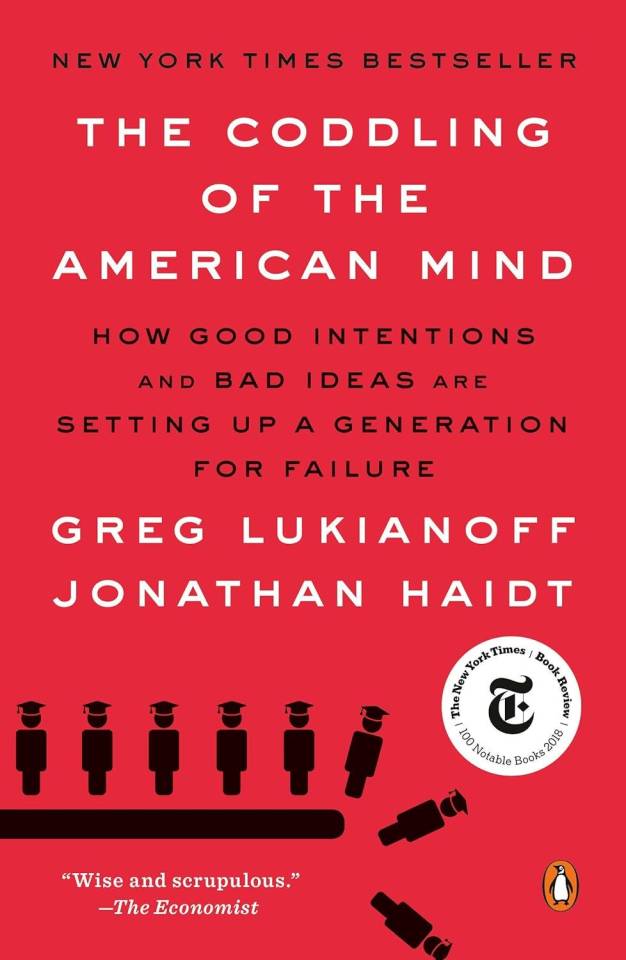
The Coddling of the American Mind tells the story of how American universities lost their collective minds, beginning around 2014 when student demands for protections from speech seemed to appear out of nowhere, including calls for trigger warnings, safe spaces, bias response teams, and mandatory trainings around language use. The students were supported by some faculty members and some administrators, and their combined force pressured many university leaders to accede to their demands even though, privately, many had misgivings.2
The new morality driving these reforms was antithetical to the traditional virtues of academic life: truthfulness, free inquiry, persuasion via reasoned argument, equal opportunity, judgment by merit, and the pursuit of excellence. A subset of students had learned this new morality in some of their courses, which trained them to view everyone as either an oppressor or a victim. Students were taught to use identity as the primary lens through which everything is to be understood, not just in their coursework but in their personal and political lives. When students are taught to use a single lens for everything, we noted, their education is harming them, rather than improving their ability to think critically.
This new morality, we argued, is what drove universities off a cliff. For a while, the descent was gradual, but at Halloween, 2015, in a courtyard at Yale, the free fall began. Students and administrators espousing the new morality demanded reforms at Yale and, over the next few months, at dozens of other schools. With a few exceptions, university leaders did not stand up to the new morality, critique its intellectual shortcomings, or say no to demands and ultimatums.
You can see the fall of higher ed in data from Gallup. The figure below shows that as recently as 2015, most Democrats and even most Republicans had high confidence in higher education as an institution. (Independents were evenly split). A mere eight years later, higher ed had alienated not just Republicans, but also independents. The trend for Democrats was down as well. The survey was fielded in June of 2023, well before the current mess.

[ Figure 1. Percent of U.S. adults with "a great deal" or "quite a lot" of confidence in higher education. Source: Gallup (2023). ]
The good news is that the academy’s free fall is now over. American higher ed hit rock bottom on December 5, 2023 in that Congressional hearing room. Anyone who wants universities to bounce back and regain the trust of the American people must understand this new morality and ensure that it never holds sway on campus again.
The key chapter for understanding the new morality is chapter 3. I recently re-read that chapter and thought it would be of help to those who are struggling to comprehend the enormity of the culture change on so many campuses since 2015. Greg and I explained the transformation as the triumph of a cognitive distortion—binary thinking—such that students learn to slot everyone into one of two boxes: oppressor or victim.3 This mindset is the psychological basis of one of the three “Great Untruths” that we found flourishing on college campuses in the 2010s: Life is a battle between good people and evil people.4 We said that this was a terrible thing to teach students, and we explained why we expected that students who embraced this untruth would damage their mental health. (Subsequent research has confirmed this prediction.)
The central portion of the chapter describes two different kinds of identity politics, one of which is good because it actually achieves what it says it is trying to achieve, and because it brings both justice and, eventually, better relationships within the group. We called this “common humanity identity politics.” It’s what Martin Luther King, Jr., and Nelson Mandela did by humanizing their opponents and drawing larger circles that appealed to shared histories and identities. The other form we called “common enemy identity politics.” It teaches students to develop the oppressor/victim mindset and then change their societies by uniting disparate constituencies against a specific group of oppressors. This mindset spreads easily and rapidly because human minds evolved for tribalism. The mindset is hyper-activated on social media platforms that reward simple, moralistic, and sensational content with rapid sharing and high visibility.5 This mindset has long been evident in antisemitism emanating from the far right. In recent years it is increasingly driving antisemitism on the left, too.
Common enemy identity politics is arguably the worst way of thinking one could possibly teach to young people in a multi-ethnic democracy such as the United States. It is, of course, the ideological drive behind most genocides. On a more mundane level, it can in theory be used to create group cohesion on teams and in organizations, and yet the current academic version of it plunges organizations into eternal conflict and dysfunction. As long as this way of thinking is taught anywhere on campus, identity-based hatred will find fertile ground.
With permission from Penguin Press, Greg and I present a condensed version of chapter 3 in a linked post, here:
What is the victim-oppressor mindset and how did it conquer the academy?
Please do go read that post, and then come back here.
OK, if you don’t want to do that right now, here is the ending of the excerpt, which offers a partial summary. After describing the social psychology of tribalism and ideas about power (from Marx, Marcuse, Foucault, and Crenshaw), we analyze an intersectionalist text in which the author (Kathryn Pauly Morgan) asserted that because men created educational systems, girls and women in those systems today are essentially a “colonized population.” Here is our response:
Morgan is certainly right that it was mostly white males who set up the educational system and founded nearly all the universities in the United States. Most of those schools once excluded women and people of color. But does that mean that women and people of color should think of themselves as “colonized populations” today? Would doing so empower them, or would it encourage an external locus of control? Would it make them more or less likely to engage with their teachers and readings, work hard, and benefit from their time in school? More generally, what will happen to the thinking of students who are trained to see everything in terms of intersecting bipolar axes where one end of each axis is marked “privilege” and the other is “oppression”? Since “privilege” is defined as the “power to dominate” and cause “oppression,” these axes are inherently moral dimensions. The people on top are bad, and the people down below are good. This sort of teaching seems likely to encode the Untruth of Us Versus Them directly into students’ cognitive schemas: Life is a battle between good people and evil people. Furthermore, there is no escaping the conclusion as to who the evil people are. The main axes of oppression usually point to one intersectional address: straight white males. [...]
In short, as a result of our long evolution for tribal competition, the human mind readily does binary, us-versus-them thinking. If we want to create welcoming, inclusive communities, we should be doing everything we can to turn down the tribalism and turn up the sense of common humanity. Instead, some theoretical approaches used in universities today may be hyper-activating our ancient tribal tendencies, even if that was not the intention of the professor. Of course, some individuals truly are racist, sexist, and homophobic, and some institutions are too, even when the people who run them mean well, if they end up being less welcoming to members of some groups. We favor teaching students to recognize a variety of kinds of bigotry and bias as an essential step toward reducing them. Intersectionality can be taught skillfully, as Crenshaw does in her TED Talk. It can be used to promote compassion and reveal injustices not previously seen. Yet somehow, many college students today seem to be adopting a different version of intersectional thinking and are embracing the Untruth of Us Versus Them.
So, how well does our analysis from 2018 hold up in 2023? Does chapter 3 help us to understand the recent explosion of antisemitism on campus?
Unfortunately, the analysis works perfectly. Many students today talk about Israel as a “settler-colonialist” nation.6 That is straight oppressor/victim terminology, from post-colonialist thinker Frantz Fanon. It treats Israel as if diaspora Jews were 19th century England or France sending colonists to take over an existing society, motivated by monetary greed. Once that frame is applied, students’ minds are closed to any other understanding of a complicated situation, such as the view that Jews are the original (or indigenous) inhabitants of the land, who had a continual presence there for 3,000 years, and whose exiled populations (many in Arab lands) had nowhere else to go after being decimated by Hitler’s version of common enemy identity politics.7 The French in Algeria could return to France, but if these students get their wish and Hamas gains control of all the territory “from the river to the sea,” it’s not clear where seven million Jews would go, other than into the sea.8
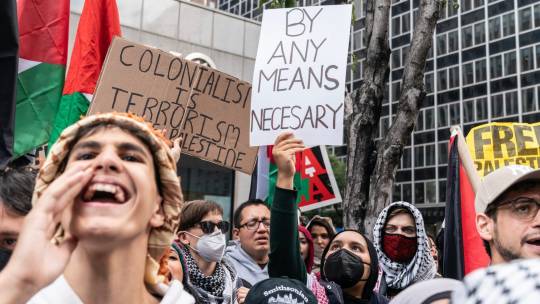
[ Image. Pro-Palestinian supporters march after a rally in New York City, October 9, 2023. Photo by Lev Radin, Shutterstock. ]
Direct evidence of the link between the oppressor/victim mindset and antisemitism was published last week in a poll from Harvard’s Center for American Political Studies and the Harris Poll. The survey was fielded on December 13-14.9 The survey asks about Americans’ beliefs not just about Israel but about Jews in America and on campus as well. I’ll summarize a few of the items, which you can check out in the report, and I'll expand on three in particular, which document the wide reach of the oppressor/victim mindset and its role in causing young people to embrace antisemitism.10
The Harvard-Harris survey found that Americans side strongly with Israel against Hamas in the current conflict––except for Gen Z (here operationalized as the 18-24-year-old age bracket)11, which is evenly divided between support for Israel and Hamas. (See p. 47 of the report.)
I should note that some have rightly criticized the Harvard-Harris poll on methodological grounds, especially for forcing respondents into binary choices, rather than offering a “don’t know” or “undecided” option. When such options are offered many people choose them, sometimes more than half, so the numbers you’ll see below probably overstate the prevalence of antisemitism, in absolute terms. Zach Rausch and I have been collecting all the recent surveys we can find on attitudes toward the Gaza conflict in this Google doc. Many other surveys have confirmed that there is substantially more support for Hamas among Gen Z than among older generations, although some studies find that Gen Z still tilts slightly toward Israel. It is the pattern of responses across questions and generations that I am drawing on, rather than the absolute numbers.
The survey found that Gen Z is not much different than older generations in agreeing that 1. Antisemitism is prevalent on campus (p. 50), 2. Jewish students are facing harassment on campus (p. 50), 3. Calls for “the genocide of Jews” are hate speech (p. 51), and 4. Calls for “the genocide of Jews” are harassment (p. 52).
Yet, despite agreeing with other generations that antisemitism is prevalent on campus, that Jews are being harassed on campus, and that calls for genocide are both hate speech and harassment, Gen Z is evenly divided as to whether campus protesters have a right to call for genocide against Jews. You can see the exact question below the table in Figure 2. As you can see below, all older generations favor disciplinary action as the proper response to students who publicly call for the mass killing of Jews. Only Gen Z does not.

[ Figure 2. “If a student calls for the genocide of Jews should that student be told that they are free to call for genocide or should such students face actions for violating university rules?” Harvard-Harris Poll, December 2023, screenshot from p. 51, with additional annotations by Haidt. ]
Why is Gen Z so tolerant of hate speech and verbal harassment of Jews, when it shows the lowest tolerance for such speech against other groups? The next three items show that the oppressor/victim mindset and common enemy identity politics are at work, but only for Gen Z. One item asked “Do you think that identity politics based on race has come to dominate at our elite universities, or do they operate primarily on the basis of merit and accomplishments without regard to race?” (p. 55). All generations agree that identity politics based on race is now dominant, but Gen Z, which has the most experience with current campus culture, agrees more strongly (69%, tied with those over 65).
The big difference between generations is that only Gen Z endorses this kind of identity politics. One survey item asks: “There is an ideology that white people are oppressors and nonwhite people and people of certain groups have been oppressed and as a result should be favored today at universities and for employment. Do you support or oppose this ideology?” [p. 56]

[ Figure 3. “There is an ideology that white people are oppressors and nonwhite people and people of certain groups have been oppressed and as a result should be favored today at universities and for employment. Do you support or oppose this ideology?” Harvard-Harris Poll, December 2023. ]
Gen Z, and only Gen Z, agrees with the “ideology that white people are oppressors.” The direct line linking this explicit form of common enemy identity politics to antisemitism is found in the responses to the next item: “Do you think that Jews as a class are oppressors and should be treated as oppressors or is that a false ideology?”

[ Figure 4. “Do you think that Jews as a class are oppressors and should be treated as oppressors or is that a false ideology?” Harvard-Harris Poll, December 2023. ]
Gen Z, and only Gen Z, agrees. As I said earlier, the absolute numbers would be lower if a neutral or “don’t know” option were presented, so I do not believe that two out of every three Americans in that age range truly believes that Jews are oppressors. But even if half of the respondents chose a third option, the balance of those who believe it to those who reject it would still tilt toward “oppressors,” and more strongly than for any older generation.
In other words: While all generations agree that race-based identity politics now dominates on campus, only Gen Z leans toward (rather than away from ) endorsing such politics, applying it to Jews, and agreeing that we should treat Jews as oppressors—that is, treat them badly and not protect them from hate and harassment because they deserve what’s coming to them.
I should offer a few clarifications.
First, it is understandable that there is an age gradient, with older generations strongly pro-Israel and younger generations becoming increasingly supportive of the Palestinian cause. Older generations were raised by parents who remembered the Holocaust and understood the context within which the state of Israel was created. Older generations remember the frequent attacks on a vulnerable Israel in its early years. Younger generations, in contrast, have only known a strong Israel that occupied Palestinian territory (at least in the West Bank). There are two sides on this issue. I’m on one side, but I understand that there are good reasons for taking the other side. Opposing Israel or hating the Israeli government is not automatically anti-semitism. What concerns me is that anti-Israel sentiment seems to be increasingly closely linked to hatred of Jews and physical attacks on Jews and Jewish sites. Such attacks may seem morally justified, even virtuous, to those who believe that Jews are “oppressors.”
Second, the Israeli military response has not been “surgical”; its bombing campaign has killed thousands of Palestinians who are not members of Hamas. Young people, most of whom are on TikTok, are probably more exposed than older people to videos of horrific suffering among Gazans. So again, I don’t criticize anyone for protesting Israel or the war, and I hope that universities respect pro-Palestinian students’ First Amendment rights to speak and protest. But the displays of support for Hamas began even before Israel had responded, and part of what was so shocking in the first week after the October 7 attack was the relatively muted and delayed expressions of concern by university leaders and campus organizations. Whatever has caused today’s campus antisemitism, it was already baked in before Israel’s military response began.
Third, I cannot say how much of today’s antisemitism comes from college classrooms (and K-12 classrooms as well), and how much is driven by social media, particularly TikTok. The rapid transition to the “phone-based childhood” that happened around 2012 is a crucial part of the story, which Greg and I discussed in The Coddling. As I have argued elsewhere, social media has introduced dangerous new dynamics into society, including explosive virality and the fragmentation of shared understandings (i.e., the collapse of the Tower of Babel). But given that today’s campus antisemitism is so closely linked with the oppressor/victim mindset, and given that Greg and I (and many others) have been warning about the dangers of teaching this mindset since before TikTok was created, I am confident that American higher education bears a substantial portion of the blame.
I do not believe that those three presidents, testifying before Congress, were antisemitic in their hearts. But in their heartless and gutless responses to a question about when it violates their campus’s rules for students to call for genocide against Jews, all three presidents validated the now-prevalent campus antisemitism. All three presidents essentially said: Jews don’t count, it’s OK to call for their deaths, as long as it does not “turn into action.”
According to those who embrace common enemy identity politics and its oppressor/victim mindset, all members of victim groups are justified in “punching up,” pulling oppressors down, vandalizing their buildings and symbols, and perhaps even raping their women and killing their children. At least, that is the implication of tweets from various professors who praised the Hamas attack, saying versions of “this is what decolonization looks like.”
Conclusion
In the tweet I quoted at the top of this essay, David Frum pointed out that elite college campuses have diverged from the rest of the country. Frum urged those of us in the academy to reflect upon why college campuses are so rife with antisemitism, in a country that is, according to public opinion data, very positive toward its Jewish citizens. I have tried to do that in this essay, concluding that it is our own fault for embracing and institutionalizing bad ideas, rather than challenging them. I have shown a direct connection between the oppressor/victim mindset and the willingness of many in the current generation of students to espouse overtly antisemitic beliefs (even if it is not truly a majority of them).
American higher education is now in a code-red situation. It’s not just Jewish donors and alumni who are withdrawing their support. As you saw in Figure 1, a majority of Americans had low confidence in higher ed before October 7. In the wake of the December 5 congressional hearings, it is now surely a supermajority, including perhaps most Democrats as well. Efforts in red-state legislatures to constrain, control, or defund higher ed will now find a great deal more public support than anyone could have imagined before 2015.
If they are to regain public trust, university leaders will need to understand the victim/oppressor mindset and how their own institutions are encouraging it. Then they will need to take bold action and make deep changes. You can’t just plant a new center for the study of antisemitism in soil that is ideal for the growth of antisemitism. You have to change the soil, change the culture and policies of the institution.
Greg and I have an entire chapter (13) on how to do that, how to create “wiser universities” by enshrining free inquiry, changing the standards used to hire faculty and admit students, and then orienting students for productive disagreement. A wiser university would make students less susceptible to the oppressor/victim mindset even if they are exposed to it in a few of their classes. I will offer many more ideas in future posts. For now, I list organizations that specialize in improving the culture of universities, and I list essays that offer what I think are good ideas. I’ll keep the list updated for a while, so if you find good essays, please post links to them in the comments.
I close this essay with the quotation that opens Chapter 3 of The Coddling, from Rabbi Jonathan Sacks, one of the wisest people I’ve ever had the good fortune to meet:
There is the moral dualism that sees good and evil as instincts within us between which we must choose. But there is also what I will call pathological dualism that sees humanity itself as radically... divided into the unimpeachably good and the irredeemably bad. You are either one or the other.
Universities can and must free students from pathological dualism.
#Jonathan Haidt#The Coddling of the American Mind#antisemitism#oppressor vs oppressed#oppressor#oppressed#oppression#pathological dualism#dualism#intersectionality#postcolonial theory#postcolonialism#colonialism#academic fraud#Hamas supporters#terrorism supporters#pro hamas#palestine#israel#pro palestine#free palestine#islamic terrorism#academic corruption#ideological capture#ideological corruption#terrorist scarf#religion is a mental illness
30 notes
·
View notes
Text
Older Nancy asking Joyce to teach her how to knit bc she could use a hobby but she makes the ugliest hats and scarves known to man but Jonathan shows them off like "look what my wife made me" 😊
#yes the smiley emoji is necessary#that's Jonathan's face#meanwhile he's holding up a lumpy black and maroon scarf like it's the most precious thing in the world#20 something Nancy cycling through hobbies is real to me#i like to imagine ahe lands on Gameboy games and she's really good at it#leading to the adult party gathering around her like the picture from the 90s of the mom and her kids#jancy#jonathan byers#nancy wheeler
35 notes
·
View notes
Text


POV you are on a dinner date with Jonathan Crane AKA The Scarecrow after a crypt tour where he was trying really hard to pretend he was not suffering from a panic attack due to claustrophobia and failed
#Photos taken by my lovely fiancée who was dressed as selina ily avery#halloween#revealing my scarecrow look#Ig I technically dressed as my tumblr url since i wore a tichel as i usually do#it only felt right to wear my 'crazy maze scarf'#jonathan crane#dc scarecrow#cosplay#halloween costume#I did freak it silently in the crypt but i was very brave about it and i made it it was fun even tho i was freaking it. Like a roller coast
13 notes
·
View notes
Text



Loewe Knot Sandals, handcrafted with 22 metres of leather tubes from s/s 2023 rtw
Creative Director Johnathan Anderson
Newest Cool
#newestcool#newest cool#ready to wear#runway collection#runway shoes#runway style#loewe sneakers#loewe ss23#loewe bag#loewe scarf#jonathan anderson#Jonathan w anderson#Jonathan w. anderson#ss2023#ss23#ss 2023#spring/summer 2023#prêt a porter#prêt à porter#Loewe heels#Loewe sandals#Loewe collection#Loewe ss23#runway sandals#runway details
25 notes
·
View notes